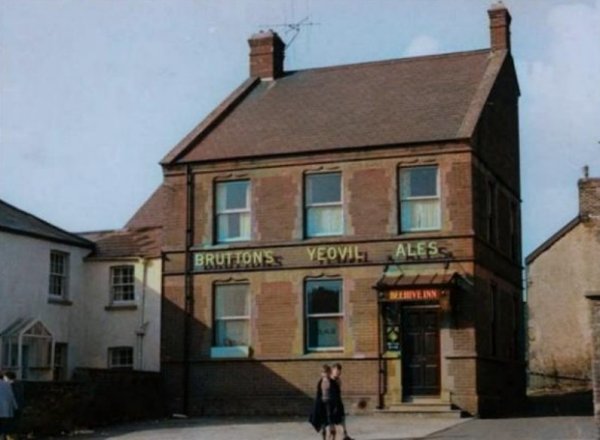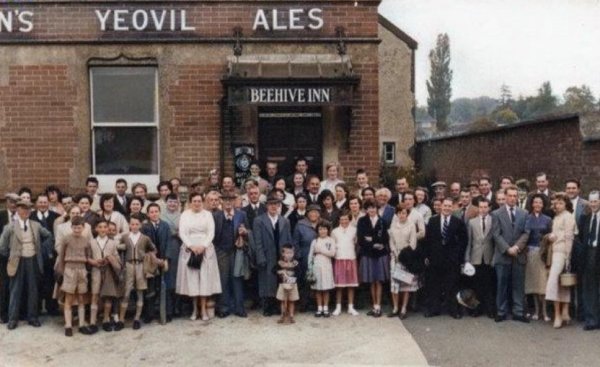Beehive Gardens
Beehive Gardens / Terrace
Set behind the Beehive Inn, Huish
There were very few buildings in Huish before the 1840s and even a map of 1901 shows Huish ending just past Grove Avenue with nothing but a footpath continuing on across the fields to Larkhill Lane, as it was then.
I was tempted to think that the original Beehive Inn may have been a cottage turned into a beerhouse following the Beerhouse Act 1830. However, early maps of Yeovil (Edward Bullock Watts 1806, Watts 1831, Day 1831, Madeley 1831 and Watts 1842) show only one tiny building in Huish which is not in the location of the Beehive.
The first map that appears to show the Beehive Inn is the 1842 Tithe Map (also by Edward Bullock Watts - see below) and marked as Parcel 604. Of course, the 1846 Tithe Apportionment lists Parcels 603 and 605 but omits Parcel 604. Nevertheless, the 1841 census recorded that James Beare was a beer seller at this location and lived there with his wife and five children. It is likely, therefore that the Beehive Inn was built around 1840.
Although the owner of Parcel 604 is missing from the 1846 Tithe Apportionment, the owner of Parcel 594 to the immediate north of the pub was recorded as James Beer - the landlord of the Beehive! At this time Beehive Gardens were yet to be built on Parcel 594.
Certainly behind the pub premises, running at right angles to Huish, was a short row of four cottages called Beehive Gardens (and also known as Beehive Terrace). It is not known exactly when Beehive Gardens was built, my best guess would be the late 1860s - they are not shown on Hickes & Isaac's 1858 map of Yeovil (see below). They are first shown on the 1886 Ordnance Survey map (see below).
The four cottages are referred to in Whitby's Yeovil Almanack Advertiser of 1882 and Collins' Directory of 1907 noted that there were four residents. The cottages had no inside toilets, but two outside privies were shared by the four families. Inside there was only cold water and a kitchen sink.
The 1881 census recorded the cottages as Bee Hive Terrace. At No 1 lived carpenter Edgar Harris with his wife Sarah and son Stephen. No 2 was occupied by 62-year-old leather parer William Genge. At No 3 lived 57-year-old general labourer Thomas Sims, his wife Matilda, machinist daughter Lucy, blacksmith son John, grandson Herbert and wheelwright William Ricketts was a lodger. Cottage No 4 was occupied by 22-year-old coachman William Curtis and his 21-year-old wife Mary.
The 1891 census again recorded the cottages as Bee Hive Terrace. At No 1 lived 60-year-old glove cutter Henry Wood with his daughter Henrietta who acted as his housekeeper. Visiting on the nigh of the census was his elder daughter Emma. Widower William Genge was still living at No 2 and Thomas and Matilda Sims were still at No 3. At No 4 was 41-year-old widowed glover Louisa Norris with her five children aged from 17 to 3.
The 1901 census saw a complete change of occupants. In No 1 was plasterer Thomas Slade, his wife Mary and their young daughter Edith. Coal merchant's carter William Cooper and his laundress wife Hannah were resident in No 2 while in No 3 were maltster George Neville, his wife Jane and their web weaver son Alfred. Finally, in No 4 was draper's porter John Crabbe and his wife Mary.
The 1911 census saw another change of residents with furniture shop porter Francis Andrews, his wife Rose and their children Olive, Dorothy and Stanley at No 1. William and Hannah Cooper remained at No 2, while 60-year-old Emily Counter lived at No 3. At No 4 were general labourer Frederick Lodge and his glove maker wife Elizabeth.
According to the 1921 census, No 1 Beehive Cottages was occupied by 60-year-old gloving machinist Sarah Jane Hannam and her 25-year-old general labourer son, Harold. At No 2 were general labourer Robert Wills with his wife Charlotte and young son Frederick. Leather glove dresser Edwin Hann lived at No 3 with his wife Lily and sons Lionel and Norman, while at No 4 were iron moulder Alfred Kemble with his wife Kate and children Beatrice and Leslie.
The cottages still appear on the 1958 Ordnance Survey map but were demolished in the late 1960s or very early 1970s.
Maps

The Beehive Inn makes its first appearance on a map - an extract of the 1842 Tithe Map of Yeovil. Huish runs along the bottom and the Beehive Inn is the right of the pair of dwellings shown in Parcel 604 at centre bottom.
Although the owner of Parcel 604 is missing from the 1846 Tithe Apportionment, the owner of Parcel 594 to the immediate north of the pub was recorded as James Beer - the landlord of the Beehive! At this time Beehive Gardens were yet to be built on Parcel 594.
As a sidenote, the terrace of seven cottages in Parcel 601 are Huish Gardens that still exist today, although heavily restored and extended, in Carisbrooke Gardens.

An extract of Hickes & Isaac's 1858 map of Yeovil with the Beehive Inn shaded pink. The cottages of Beehive Gardens are apparently yet to by built.

The first map (that I have) showing the cottages of Beehive Gardens (shaded in pink) is this 1886 Ordnance Survey map.
gallery

Photograph (colourised) of 1960 by Charrington & Co Ltd's surveyors as part of a 'stocktaking' exercise of photographing Brutton's pubs prior to the brewery takeover.
Notice, at extreme right, the only known photograph of the end wall of the cottages known as Beehive Gardens. The site of the cottages now forms part of the pub's car park.

Regulars and their families prepare for a day out - I'm guessing late 1960s - by which time the cottages of Beehive Gardens have been demolished.

All that remains today to remind us of Beehive Gardens are the ghosts of four blocked-up windows in the wall of the Beehive Inn's car park. At one time these were in the back wall of the cottages and overlooking open fields.